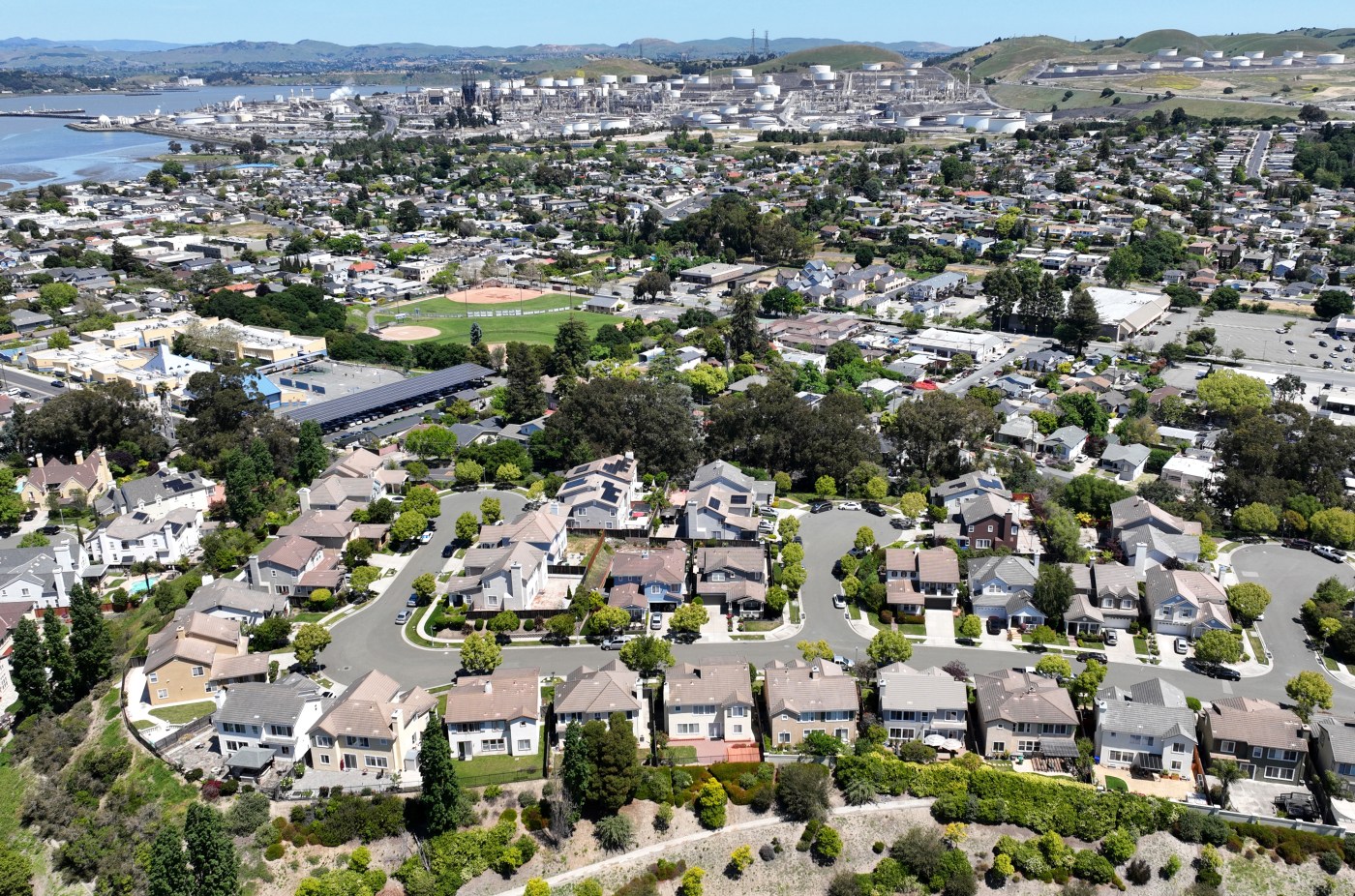HERCULES — On the surface, Victoria by the Bay is a charming neighborhood of 926 homes only a short walk from the shores of San Pablo Bay.
Related Articles
Construction underway on tiny home shelter site at Sobrato property
San Jose housing tower sued for poor upkeep, lack of heat, cooling
Gilroy State of the City paints an up and coming city – with some growing pains
Affordable housing project with 64 units for homeless people opens in downtown San Jose
Silicon Valley billionaire’s campaign to build new Bay Area city submits signatures to get on November ballot
But the ground beneath the roughly 200-acre development was once home to the former Pacific Refinery Co., a facility built in 1966 that produced 55,000 barrels of oil daily and stored other hazardous substances in the northernmost corner of Hercules, adjacent to Rodeo. Amid a bleak economic outlook for the fossil fuel industry at the time, the facility was decommissioned in the summer of 1995, and demolished not long after.
It was replaced by a plan to transform its contaminated “brownfield” land into the residential subdivision that was completed in 2003 — a vision of coastal-view homes and preserved greenspace that required extensive remediation of the soil and groundwater that had been polluted there over three decades.
Now, officials in Contra Costa County are wondering if Victoria by the Bay could be a model for the shifting energy and housing needs of other communities.
A growing number of refineries around the county have shuttered in recent years, as many states pivot away from fossil fuels — such as California’s ban on sales of new gas-powered cars within the decade — and exorbitant costs are required to upgrade often century-old equipment and infrastructure. Some petroleum processing facilities have started transitioning to biofuels in an effort to reduce greenhouse gasses — and stave off the threat of being decommissioned and demolished — but for many, the future is uncertain.
The former Pacific Refinery Co., built in 1966, produced oil and stored other hazardous substances in Hercules, adjacent to Rodeo. Operations at the facility shut down in 1997. (Courtesy of Contra Costa County)
Four refineries are still churning within Contra Costa County: the Marathon Martinez Refinery, Chevron Richmond Refinery, Phillips 66 in Rodeo and the Martinez Refining Company.
On Monday, the county’s Sustainability Commission, which advises implementation of the county’s Climate Action Plan, took a closer look at Victoria by the Bay as a possible test case officials can study to guide future remediation projects if those refineries shut down, too.
Mike Moore, the commission’s chair, said the project provides local insight into the immense collaboration required to balance state, county and city laws, in addition to requirements and tests from a slew of environmental agencies.
However, Monday’s commission meeting also made clear that there’s no one-size-fits all plan for how to transform these industrial plots of land.
Little is still known about the possible long-term health, safety and financial risks associated with remediation and redevelopment projects. Commission members Shoshana Wechsler and Norman Cohen specifically asked about how the county can ensure continuous monitoring of toxicity levels in neighborhoods like Victoria by the Bay, as well as the full extent of cancer diagnoses among residents over time — questions that currently lack any clear answers.
In 2004, steel tanks loom over brand new homes at a subdivision on the site of the old Pacific Refinery Co in Hercules. (Eddie Ledesma/Contra Costa Times Archives)
“I think we have a confounding influence of the age of the refineries — not just how long they have been running, but also what technology they were founded on initially, so each one may have a different characteristic in terms of ground contamination,” Cohen said. “It’s great that they were able to remediate that (Pacific Refinery), but we need to know more to compare apples to apples.”
It took several years to clean up the former Pacific Refinery site, which the Hercules City Council sold for $4.7 million in March 1997 to Hercules LLC, a subsidiary of Catellus Development Corp.
Crews hauled out soil, extracted toxic vapors and filtered ground water under guidance from agencies like the Regional Water Quality Control Board and Bay Area Air Quality Management District, which cleared more than a half-million pounds of hydrocarbons from the property by July 2000, according to commission records.
That work was deemed complete by the end of 2001 — nearly three years after the clean-up plan was first approved.
The list of defunct refineries in California has only grown in the years since.
In August of 2022, the Phillips 66 Company in San Luis Obispo asked county officials for permission to demolish and remediate its Santa Maria Refinery facility, which halted operations at 2555 Willow Road in Arroyo Grande by Jan. 2023. A 714-page draft Environmental Impact Report for that extensive process was released last month and will be open for public review until May 6.
A drone view of the Phillips 66 San Francisco Refinery near the Bayo Vista neighborhood in Rodeo, Calif., on Tuesday, April 30, 2024. (Jane Tyska/Bay Area News Group)
As Phillips 66 prepares permits and permissions, it’s still unclear just how expensive that multi-year process will be, or what kind of development — if any — will utilize that soon-to-be vacated space.
That’s why some members of the Sustainability Commission discussed tapping the Gov. Gavin Newsom’s office to help put concrete rules and regulations and policies in place if one of the county’s refineries close, in addition to working with organizations crafting a just transition plan for these kinds of plants.
Chuck Leonard, who sits on the county board as a political representative for the plumbers and steamfitters of Local Union 342, emphasized the need to start creating a clear plan to manage the potential legal and financial liabilities associated with remediation — preferably before any plans for future development materialize.
“It’s of dire concern if a plant closes, and a refinery just decides to walk away,” Leonard said Monday. “What’s going to happen to a plant that’s 120 years old that has 100 times more challenges than what happened right there in Hercules?”
Staff researcher Veronica Martinez contributed to this story.












